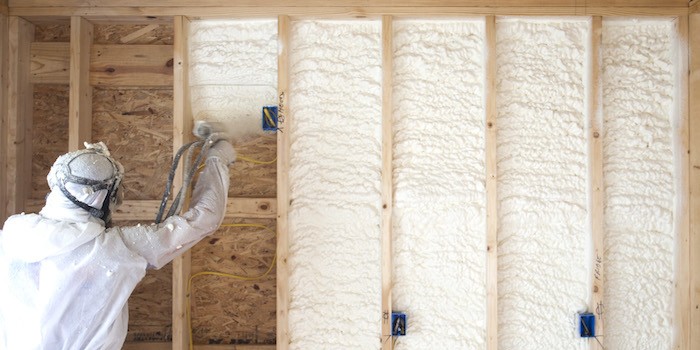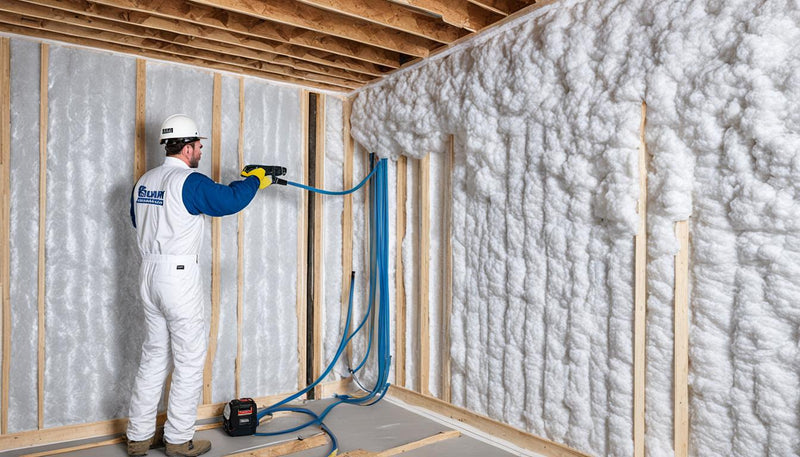The Process of Using Spray Foam: What You Required to Know
The Process of Using Spray Foam: What You Required to Know
Blog Article
Spray Foam: The Ultimate Service for Air Sealing and Insulation
Spray foam insulation has actually become a leading remedy for reliable air securing and thermal insulation, using an one-of-a-kind mix of residential or commercial properties that set it besides conventional methods. Its ability to expand and fill gaps makes it particularly efficient in avoiding air leakage, which can dramatically influence energy performance. Nevertheless, recognizing the full range of its benefits, installment procedures, and contrasts with various other insulation kinds is critical for making educated choices. As we check out these facets, the implications for both brand-new constructions and retrofits end up being progressively considerable. What factors should affect your option?
What Is Spray Foam?
Spray foam is a functional insulation product that incorporates the principles of air sealing and thermal resistance to improve power efficiency in buildings. Composed primarily of polyurethane or various other similar substances, spray foam is applied as a fluid that increases upon contact with surfaces, producing a solid, continuous layer of insulation. This unique property permits it to fill up gaps, fractures, and gaps that conventional insulation products might neglect, offering a premium air seal.
There are two major sorts of spray foam: open-cell and closed-cell. Open-cell spray foam is lighter and much more adaptable, supplying superb sound absorption and a lower R-value per inch - Spray Foam. In contrast, closed-cell spray foam is denser, supplying a greater R-value, dampness resistance, and included architectural stability to developing elements
The application process generally entails specific tools, making certain a seamless application that abides by various substrates, consisting of metal, timber, and concrete. This adaptability makes spray foam ideal for both brand-new constructions and retrofitting existing frameworks. Its ability to develop a closed obstacle substantially adds to minimizing energy usage and enhancing indoor air high quality, thereby making it a recommended selection amongst building contractors and house owners alike.
Advantages of Spray Foam Insulation
Among the most significant benefits of spray foam insulation is its exceptional capacity to create a continual air barrier, which successfully minimizes energy loss. Unlike conventional insulation materials, spray foam expands to fill up voids and splits, guaranteeing that air leak is substantially reduced. This characteristic not just enhances power effectiveness yet also brings about reduce utility bills gradually.
Additionally, spray foam insulation supplies superior thermal resistance, adding to a more steady interior atmosphere. Its high R-value per inch enables effective insulation in confined spaces, making it optimal for attics, wall surfaces, and crawl rooms. Moreover, the moisture-resistant properties of spray foam aid stop mold and mildew and mildew growth, advertising healthier living problems.
One more critical benefit of spray foam insulation is its sound-dampening qualities (Spray Foam). It efficiently minimizes noise transmission in between spaces, creating a quieter and more comfy home atmosphere. The durability of spray foam also stands apart, as it does not sag or work out over time, preserving its performance throughout its lifespan
How Spray Foam Works
Understanding how spray foam insulation works is essential for appreciating its performance in air sealing and thermal resistance. Spray foam insulation consists of 2 primary elements: isocyanate and polyol material. When these parts are blended, they undertake a chemical response that creates the material to broaden rapidly, developing a thick foam that fills up dental caries, spaces, and fractures.
As the foam expands, it abides by surfaces, developing an impermeable seal that dramatically minimizes air seepage. This particular makes spray foam insulation highly effective at protecting against drafts and wetness infiltration, which can bring about power loss and damage over time. In addition, the closed-cell variant of spray foam uses exceptional thermal resistance because of its rigid structure, effectively reducing warm transfer.
The distinct residential properties of spray foam permit it to adhere to uneven surfaces, ensuring comprehensive coverage and a smooth barrier. Because of this, spray foam insulation not only boosts energy efficiency however likewise adds to improved interior air high quality by reducing the buildup of pollutants and allergens. Ultimately, recognizing the mechanics behind spray foam underscores its role as a remarkable selection for insulation and air sealing in both industrial and household applications.
Installment Refine Introduction

Before installment, the space has to be properly cleaned up and prepped, making sure that surface areas are without dirt, wetness, and particles. This action is crucial due to the fact that impurities can endanger adhesion and general performance. As soon as the location is prepared, the application involves mixing the 2 components of the spray foam, which increases upon call and loads voids successfully.
Trained specialists need to carry out the installment, making use of customized equipment to guarantee uniform coverage and ideal thickness. Safety and security precautions, including putting on protective gear and guaranteeing correct ventilation, are important during this process. After application, the foam commonly cures rapidly, forming a strong obstacle that boosts power efficiency.
Contrasting Spray Foam to Standard Insulation
When blog here examining insulation choices, find here spray foam insulation stands out in comparison to conventional products such as fiberglass and cellulose. Unlike fiberglass and cellulose, which can enable air infiltration, spray foam increases upon application, filling voids and gaps to produce an airtight seal.
Furthermore, spray foam provides a higher R-value per inch than traditional insulation types, offering more efficient thermal resistance in a thinner profile. This characteristic is especially helpful precede with minimal tooth cavity deepness. Moreover, spray foam is resistant to dampness and mold and mildew growth, which can be a considerable worry about cellulose and fiberglass, particularly in moist atmospheres.
Nonetheless, spray foam insulation typically lugs a greater in advance cost than its standard equivalents. Home owners must weigh this first investment versus lasting energy cost savings and efficiency advantages. Eventually, while both insulation types offer their purpose, spray foam becomes an advanced service for modern insulation demands, especially in regards to air securing and thermal effectiveness.

Conclusion
In recap, spray foam insulation represents a very efficient option for accomplishing ideal air securing and thermal resistance. Its distinct buildings, including dampness resistance and audio dampening, make it suitable for various applications in both brand-new constructions and retrofitting tasks (Spray Foam). The first costs may be higher contrasted to standard insulation materials, the long-lasting advantages, such as significant energy cost savings and improved indoor air quality, justify the discover this financial investment and highlight its value in contemporary building practices.
Spray foam insulation has actually emerged as a leading option for effective air sealing and thermal insulation, providing an one-of-a-kind combination of residential or commercial properties that set it apart from standard methods.Spray foam is a functional insulation product that integrates the concepts of air securing and thermal resistance to improve power efficiency in structures.When evaluating insulation choices, spray foam insulation stands out in contrast to standard materials such as fiberglass and cellulose. Inevitably, while both insulation kinds offer their function, spray foam arises as a more advanced remedy for contemporary insulation requirements, specifically in terms of air securing and thermal performance.
In summary, spray foam insulation stands for a highly reliable service for achieving optimal air securing and thermal resistance.
Report this page